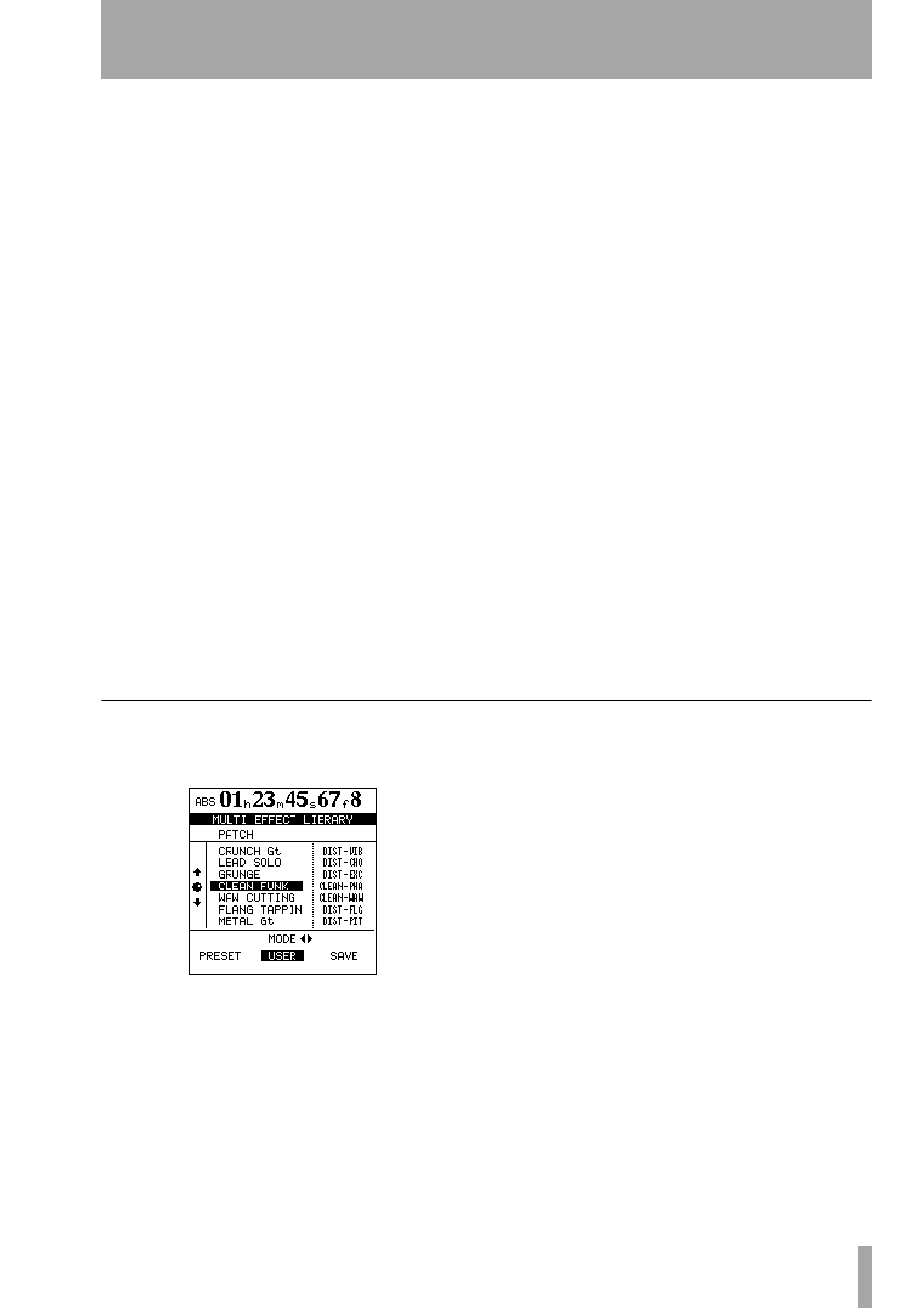Using the multi-effect library, Modulation effects, 3 – effects – Teac 2488 User Manual
Page 33

3 – Effects
TASCAM 2488
User’s Guide
33
•
DST
: Distortion. Either this effect or the compressor
(below) is in the second position in the chain.
Adjust the
DISTORTION
level,
TONE
and amount of
POST GAIN
(gain applied after the effect). You can
also
SWITCH
this effect on or off (in or out of the
chain).
•
CMP
: Compressor. Either this effect or the distortion
(above) is in the second position in the chain.
Adjust the
THRESHOLD
, compression
RATIO
, the
COMP
LEVEL
, and the amount of
DIRECT MIX
. You can also
SWITCH
this effect on or off (in or out of the chain).
•
AMP
: Amplifier model. This effect is always the
third in the chain. Adjust the
PRE GAIN
(corresponds
to pre-amplifier gain setting, the
TONE
, the
BOX SIZE
(speaker cabinet size), and the
POST GAIN
(overall
output volume). You can also
SWITCH
this effect on
or off (in or out of the chain).
• Modulation, etc. effects (see below). One of these
effects is always in the fourth place in the chain.
•
DLY
: Delay. This is always the final effect in the
chain. Adjust the
DELAY TIME
, amount of
FEEDBACK
,
HI DAMP
(the amount by which high frequencies are
damped with successive repeats) and the overall
MIX LEVEL
. You can also
SWITCH
this effect on or off
(in or out of the chain).
Modulation effects
One of the following effects
always takes the fourth place in the chain.
•
FLG
: Flanger. Adjust the
SPEED
,
DEPTH
,
RESONANCE
and
MIX
level of this flanging effect. You can also
SWITCH
this effect on or off (in or out of the chain).
•
PHA
: Phaser. Adjust the
SPEED
,
DEPTH
and
RESONANCE
of this phasing effect. You can also
SWITCH
this
effect on or off (in or out of the chain).
•
CHO
: Chorus. Adjust the
SPEED
,
DEPTH
,
TONE
and
MIX
level of this chorus effect. You can also
SWITCH
this
effect on or off (in or out of the chain).
•
EXC
: Exciter. Adjust the
FREQUENCY
and
DEPTH
of this
exciter effect. You can also
SWITCH
this effect on or
off (in or out of the chain).
•
PIT
: Pitch shifter. Adjust the
PITCH
(in semitones)
and use the
FINE
setting for fine-tuning. Set the
MIX
LEVEL
. You can also
SWITCH
this effect on or off (in
or out of the chain).
•
TRM
: Tremolo. Adjust the
SPEED
and
DEPTH
as well
as the
SHAPE
of the waveform. You can also
SWITCH
this effect on or off (in or out of the chain).
•
VIB
: Vibrato. Adjust the
SPEED
and
DEPTH
of this
vibrato effect. You can also
SWITCH
this effect on or
off (in or out of the chain).
•
WAH
: Wah effect. Adjust the
ATTACK
of the effect,
the
SENSE
(sensitivity) of the effect, and whether the
PEDAL
(the
EXPRESSION
pedal connected at the
front of the unit) is used or not to control the effect
(if
OFF
, this becomes an auto-wah effect).
Using the multi-effect library
1
From the multi-effect parameter screen, press
ENTER
:
2
Use the left and right cursor keys to select
either the
PRESET
memory banks, the
USER
memory banks, or
SAVE
the current setting.
The left side of the
PRESET
memory banks pro-
vides a description of the effect (
GRUNGE
,
LEAD
SOLO
, etc.).
In the right column, you can see the chief com-
ponents of the effect. The first part of the
name represents the second effect in the chain
(either
DIST-
for distortion, or
CLEAN-
for com-
pression, followed by one of the eight modula-
tion effects (
FLG
,
PHA
,
CHO
,
EXC
,
PIT
,
TRM
,
VIB
, and
WAH
). There are therefore 16 “starting points”
for multi-effect settings.
3
To save the current settings as an effect in the
USER
bank, move the cursor to
SAVE
and press
ENTER
. Select an existing effect to overwrite,
or pick a new library entry into which to save
the parameters.
You can rename any entry in the user banks
using the techniques described in “Titling” on
page 12. The basic type of effect (for instance,
DIST-FLG
) is always shown in the right column
of the list, so even if you call it
HEAVY LEAD
, for
example, you can still recognize the basic
starting point.
